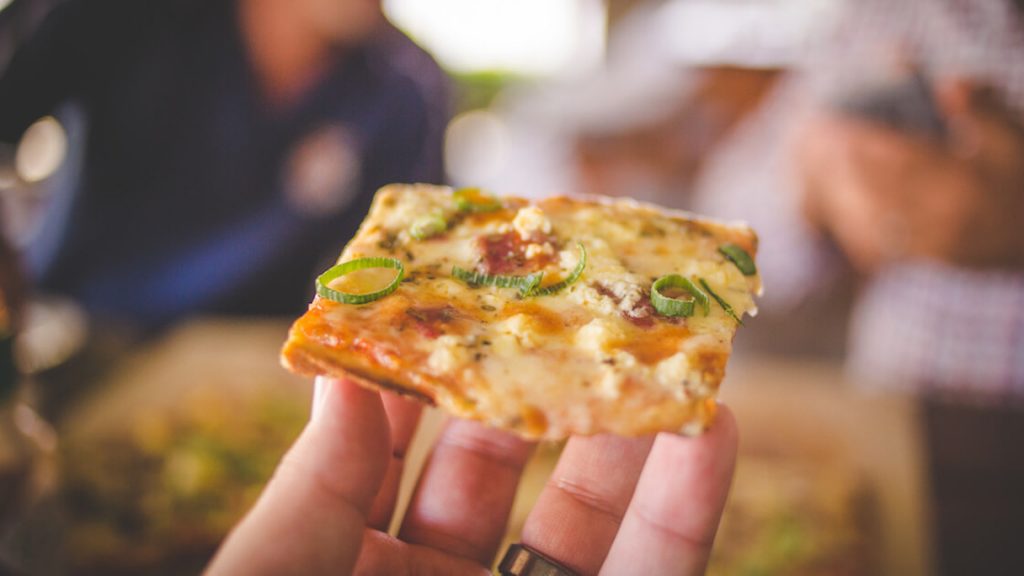
By Aditi Shrikant | Rewire
In Wisconsin, farm-to-table is more than just a buzzword. The state, touted for its cheeses, is adding even more value to it’s 14.3 million acres of farmland by converting a portion of their abundance of crops into something everyone loves—pizza.
The enticing, yet somewhat misleading, name “pizza farms” refers more to a season than a place, which on most pie-providing farms is May through October. It’s during this time that farms designate a couple nights a week to serve pizza made from crops grown on the land to whoever makes the drive out to eat it.
“There is a super collaborative sustainable farming movement here in Wisconsin,” said Lisa Kivirist, coordinator of Come & Get It, a project that aims to help farmers take advantage of agrotourism opportunities. The project is part of Renewing the Countryside, a nonprofit with a goal to invigorate the rural areas of the U.S.
Getting folks to the farm
AtoZ Produce and Bakery in tiny Stockholm, Wisconsin, population 75, is considered to be the first farm that saw an opportunity to diversify its income—while using an abundance of crops that may go bad otherwise—by making pizza.
Before pizza farms took off, diners used to be people from within the community. Now these farms feed people from far out midwest metropolises like Chicago and Minneapolis.
“It’s a great portal to invite people out to farms because it’s not a $200, white-cloth, farm-to-table dinner—it’s just pizza,” Kivirist said.
Pizza farms create a touchpoint for those of us to whom farming feels like an abstract concept, or something people only did a long time ago. One visit to a pizza farm squashes the antiquated American Gothic-esque image many have of the family farmer and replaces it with one of a young innovator creating locally sourced dishes.
“I don’t want family farmers to be murdered off because the (food) industry is saying get big or get out,” said Tony Schultz of Stoney Acres Farms in Athens, Wisconsin. “It’s bad for society. It’s bad economics. It’s bad for communities.”
Schultz tells folks who call him for advice on how to start a pizza farm to start with the Health Department, then work backwards.
“Just do what you need to do to meet those codes,” he said. “Then the real work is hustling your butt off and working to bring food to the table.”
Pizza and puns
Schultz, 38, grew up on Stoney Acres. He’s a third-generation farmer and has been serving pizza at the farm for the past six years.
“To me, a pizza farm is a way to preserve the family farm by creating added value, a farm-to-table experience and elevating the work of the family farm into a public community event,” he said. “It’s a destination that’s centered in this pastoral setting that is beautiful and authentic.”
Among the 80 vegetables and herbs he grows are garlic, tomatoes, carrots, mushrooms and arugula. He also grows grain and raises about 60 pigs to use for the meat that goes on his pizzas.
The only thing he doesn’t make on the farm, and instead buys locally, is cheese.
His most popular pies include “The Athens Greek” with roasted cherry tomatoes, spinach, feta, sausage and garlic sauce, and the “Karen Filippelli” with garlic sauce, bacon, baby arugula and parmesan.
As a farmer and a chef, Schultz is always trying to find new ways to use what grows on his farm.
“One of my favorite thing to do is use the marathon red clovers,” he said. “When I move cows from pasture to pasture, I pop off the clover head and they’re like a little sugar blast. It just grows in my field.”
He uses the blossoms to top his “It’s All Clover Now Baby Blue” pizza, made with blue cheese, bacon, kale, basil and pesto.
Changing and growing (ingredients)
Suncrest Gardens in Cochrane, Wisconsin, has been serving pizza for 13 years. Owner Heather Secrist, 40, grew up on a farm, but left to pursue other opportunities before purchasing Suncrest 15 years ago.
“I don’t think I realized the impact that really had on me,” she said. “I felt that part of my roots in agriculture and working with the land and being outside and being my own boss were all really strong attributes of growing up.
Soon after buying the farm, she put in a processing kitchen to add more value to the land and diversify her income.
The menu at Suncrest is comprised of some classic constants like pepperoni and Hawaiian, but also some seasonal pies. The farm also serves appetizers like egg rolls and salads along with fresh baked cookies and s’mores kits.
Secrist purchases grain and cheese from other local farms, but grows most of her own vegetables. Olives and artichokes are purchased from Italy and her olive oil is sourced from California.
“Everything we can grow, we do grow, and we try to source clean products,” Secrist said.
One of the things Secrist loves about the farm is its ability to evolve.
”It’s just part of our lives and you can kind of keep tweaking it as it grows and changes and as you grow and change,” she said.
![]() This article originally appeared on Rewire.
This article originally appeared on Rewire.
© Twin Cities Public Television - 2018. All rights reserved.
Read Next



